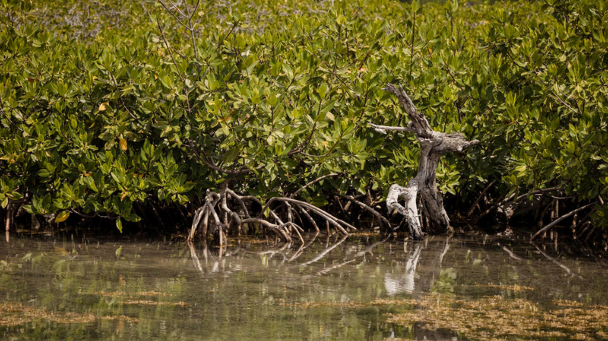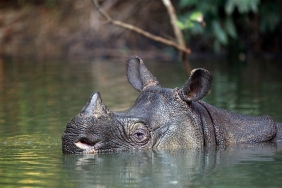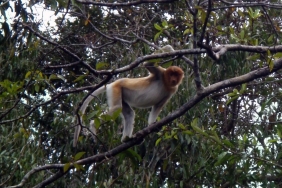MANGROVES, SHIELDING THE LAND FROM WAVES IN LABUAN BAJO
World Mangrove Day was inaugurated by UNESCO in 2015 and is commemorated every July 26. This commemoration aims to raise awareness about the importance of mangrove ecosystems and promote sustainable mangrove conservation. In Indonesia, based on the National Mangrove Map by the Ministry of Environment and Forestry in 2021, Indonesia has a total mangrove area of 3,364,080 Ha.
Taking this momentum, the East Nusa Tenggara Provincial government through the Branch Office of the Marine and Fisheries Service of the East Manggarai, Manggarai, and West Manggarai Working Areas, with the support of the Indonesian Capital Market and the WWF-Indonesia conducted a webinar with the theme 'The Role of Mangroves as the Front Guard to Protect Land from Waves' attended by 90 participants. Mangrove conservation in Labuan Bajo is one of the major programs supported by the Indonesian Capital Market, including planting mangrove trees and education about the importance of mangroves for the ecosystem, both to local communities and tourists traveling to Labuan Bajo.
Acting Head of the Marine Fisheries Service of NTT Province, Stefania Tunga Boro, S.Pi, MM., said "We need to pay attention to the role and function of mangroves, with various kinds of threats that occur in development and other human activities, the existence of mangroves around us is very important. One of them is if we see mangroves as land protection from waves, "he said when opening the webinar.
This webinar also presented four speakers consisting of government representatives, environmental practitioners, and community groups, namely Robertus Eddy Surya, S.Pi MP., as Head of the East Mangarai Office, Manggarai, and West Manggarai Branch; Paspha Ghaishidra Muhammad Putra as Public Relations Manager of IKAMaT (Inspiration of Kesemat Alumni Family); Ahmad Burhan as Chairman of the True Nature Group; and Muhammad Erdi Lazuardi from WWF Indonesia Foundation.
This discussion also began with various regulatory information on maintaining the preservation of mangrove ecosystems, one of which is contained in Law of the Republic of Indonesia No. 1 of 2014 concerning Amendments to Law of the Republic of Indonesia No. 27 of 2007 concerning Management of Coastal Areas and Small Islands. Robertus Eddy explained the physical, ecological, and economic functions of mangroves. Physically the existence of mangroves can dampen storms, tsunami waves, and abrasion. Ecologically mangroves function in the process of primary productivity, spawning, breeding/enlargement, and foraging for many biota, especially various types of fish, crabs, and shrimp, export nutrients, pollutant traps, and carbon sinks. Economically, many benefits can be obtained either directly or indirectly, including environmental services.
IKAMaT and the Alam Sejati group also expressed their views on carrying out mangrove protection schemes, rehabilitation efforts, mangrove ecosystem utilization, and community education. Mangrove protection schemes can be through research or data harvesting, training, making mangrove products, media, and donations. IKAMaT carried out rehabilitation efforts in Serang and Tulungagung cities covering an area of 103.69 Ha with a survival rate of 71.3 percent of mangrove seedlings, while the Alam Sejati group carried out rehabilitation efforts in Golo Sepang Village covering an area of 53 Ha with a life success of around 60-70 percent.
Another interesting lesson was also conveyed by Ahmad Burhan, "The process of planting mangroves is carried out collaboratively by local communities where at first they did not know if mangroves have ecological benefits to protect land from the threat of waves and abrasion."
There are several collaboration spaces that can be done in West Manggarai Regency including the development of mangrove tracking development, public education for both school and public students, institutional strengthening to master digital information, supporting facilities for mangrove planting, supervision of activities carried out in mangrove forests and regular research. "One tree can be a forest, one smile can be a concern, one kindness will bring blessings," Burhan concluded.
The development of Conservation Areas in Indonesian waters also supports the preservation of mangrove ecosystems. "Opportunities and challenges from the aspects of natural, socio-economic and cultural assets and governance, namely Conservation Areas need to be managed effectively, optimizing mangrove protection in protected areas in waters, which is currently only 2%. It can also optimize mangrove-based economic opportunities such as tourism, and fisheries," said Muhammad Erdi Lazuardi.
The government is still targeting to restore mangrove ecosystems of 600,000 ha. Erdi also said that the community can play a role by carrying out activities in accordance with existing guidelines, participating in mangrove planting actions, reducing the use of single-use plastics, or being active in networks or environmental activists.





